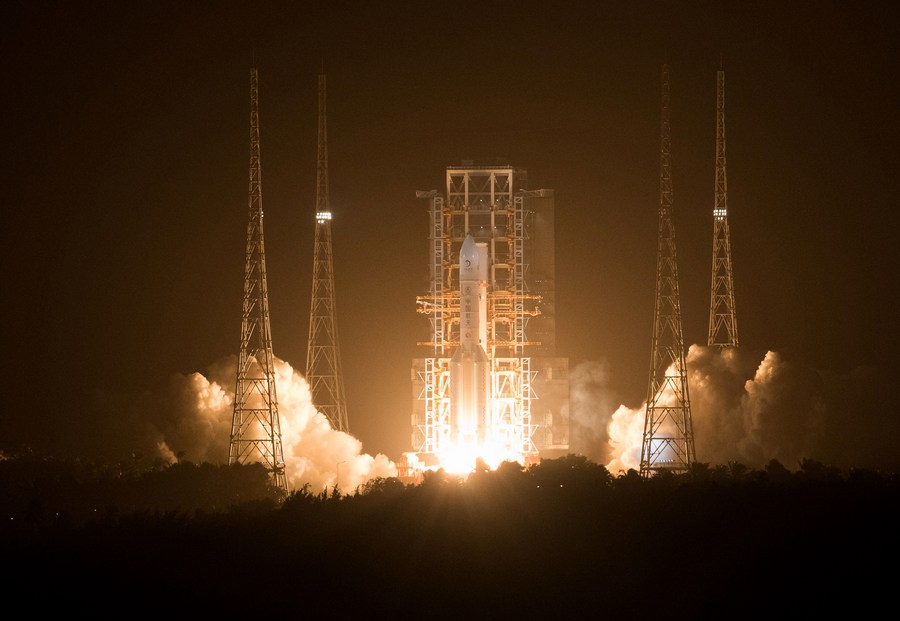Chang'e 5 launched to fetch moon samples
By ZHAO LEI in Wenchang, Hainan | CHINA DAILY | Updated: 2020-11-25 07:07

If the Chang'e 5 mission ends successfully, it will be China's first space activity to retrieve extraterrestrial substances and will also make China the third nation in the world to bring lunar samples back after the United States and the then Soviet Union.
Moreover, the mission's success will make Chang'e 5 the world's first lunar sample-return spacecraft since August 1976 when the Soviet Union's unmanned Luna 24 brought 170.1 grams of lunar samples back to Earth.
According to the space administration, the Chang'e 5 mission is intended to fulfill several objectives.
In terms of space engineering, it will demonstrate and verify technical plans and apparatus for autonomous lunar sampling and packing, moon-based launching as well as lunar orbital docking.
In the scientific field, it will investigate the landing site's geological and topographical features, and enable scientists to analyze the structure and physical traits of lunar samples so they can deepen their research of the moon's origin and evolution.
The administration added that the mission will also help to foster the country's knowledge, technology and talent pool for future manned missions to the moon and other deep-space expeditions.
Pei Zhaoyu, a spokesman for the mission, said if the mission is successful, it will be a milestone in the nation's lunar exploration endeavors and will show the world China's scientific, technological and engineering capabilities.
Furthermore, Chang'e 5 will strengthen the nation's status and influence in the international space community, pave the way for the country's future lunar expeditions and boost its space science, and will also offer more opportunities to lunar researchers around the world, Pei said.
Scientists around the world are welcome to participate in the research of the lunar samples brought back by the mission. China will publish a set of guidelines about the use and distribution of the samples after the mission, said Pei, who is deputy director of the administration's Lunar Exploration and Space Program Center.
His remarks were echoed by Xing Qiang, founder of Micro-Rocket Union, a nonprofit space research organization in Beijing.
Xing said if everything goes well in the mission, about 2 kg of lunar rocks and soil will be sent back and that will mean a lot to Chinese scientists, not only scientifically but also emotionally.
"Currently, China has only 1 gram of lunar sample-a tiny piece of rock-that was collected on one of the US Apollo missions. The stone was later divided into two equal pieces. One piece was used for scientific study and the other was sent to the Beijing Planetarium for public display," he said. "For a long time we had been unable to collect more lunar samples by ourselves, but now Chang'e 5 will bring as much as 2 kg of stones and dirt back to us. You can imagine what this will mean to our scientists."
The samples to be retrieved by the Chinese vehicle will bring abundant benefits and opportunities to Chinese scientists and their foreign counterparts, he said, adding that the mission also will earn China a place in the elite club of space powers able to carry out deep-space sample return operations.
Enduring efforts
The design work on Chang'e 5 began in January 2011 and was concluded in December 2012, and then designers and engineers started building the probe's prototype. Construction of Chang'e 5 began in December 2015 at the China Academy of Space Technology.
The mission was originally scheduled to be completed by the end of 2017, but the plan had to be postponed due to technical problems with the Long March 5 rocket, which had a launch failure in July that year.
Since then, engineers had continuously improved the mission's overall reliability and spared no efforts to ensure the program can eventually succeed, said Ye Peijian, a leading scientist in deep-space exploration at the China Academy of Space Technology.
Before Chang'e 5, 20 successful soft landings have been made on the moon by the US, the Soviet Union and China. The most recent, and still operational, are China's Chang'e 3 and Chang'e 4 missions.
























